
A side benefit is that it is lighting fast (the first version had 10+ second waiting times - which is extremely slow by internet standards). With that "breakthrough", the tool can now read the data directly on your computer, thus the data never leaves your computer - making it safe for both me, the author, and you the user. The documentation provided by Phil Harvey on his website again made this possible. The second version was created in the fall of 2018 and featured a simple EXIF decoding implementation in JavaScript - the "programming" language that enables most of the fancy stuff on the web. Using the ExifTool application also meant that the files had to be uploaded on one of my servers, which meant that with time more and more problems were being caused by the tool (not to mention all the hacking attempts). (You can read more about it in this thread about the tool)
SONY ALPHA SHUTTER COUNTER FREE
The first tool used the free and opensource application ExifTool by Phil Harvey (Credit to that person!) to extract the required data from SONY ARW and JPG files.

Many of the basic photographic specs are the same or very similar to those of the D80, although there’s a new shutter and an implementation of the 3D tracking AF seen on the D3/D300.The tool was created in april 2013 when a user called Micholand posted a way to read shutter count information on the A900.

SONY ALPHA SHUTTER COUNTER MOVIE
More surprising is the inclusion of the world’s first DSLR movie mode (with 720p HDTV quality, no less) and HDMI output, although as we’ll see later, it comes with some limitations. Of course it has Live View with contrast-detection AF and it would be surprising if it didn’t have a dust removal system.
SONY ALPHA SHUTTER COUNTER ISO
Because it looks so much like the D80, the D90 seems at first glance to be one of those rather underwhelming incremental upgrades, but dig a little deeper and you’ll find that there’s plenty to make Nikon fans happy.įirst of all there’s a new CMOS sensor, which Nikon claims produces D300-quality results up to ISO 6400 and – one of the many features “trickling down” from the higher-end models – the same much-vaunted 3.0-inch VGA screen as the D3/D300. The D80 has been one of Nikon’s quiet successes, and even today, despite positively resembling Methuselah in digital camera terms, it continues to sell and often makes the top 10 most clicked cameras. The Coolpix S7000 does have some drawbacks, which is common for an inexpensive point-and-shoot camera, but it still compares favorably to its similarly priced competitors.Īlmost exactly two years after the announcement of the D80 comes its replacement, the rather anticipated D90. Having a slim camera with such a large zoom lens is great because it provides a lot of options for setting up your photographic scenes. At this price point, it’s a good deal, as the S7000 features a 20X optical zoom lens.


The price of the S7000 varies quite a bit depending on the retailer, but you can usually find it for less than $250 and sometimes as the best digital camera under $200. If you like this camera, you’ll like our recommendation for the best digital camera. Another excellent budget model is the Sony DSCW800/B – Best Budget Compact Camera. And this review of the Nikon Coolpix S7000 shows that you can find flexibility in a low-priced camera. But you don’t want to give up too much, especially in key areas like the number of resolutions and optical zoom lens metering. When you’re looking for a cheap point-and-shoot camera, you know you’ll have to give up a few features you’d like to have.


 0 kommentar(er)
0 kommentar(er)
